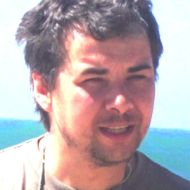Mathematical methods of cortical wave localization from noninvasive MEG and EEG data
Cortical traveling waves (Figure 1) are a cerebral phenomenon that is expressed in the activation of the cerebral cortex in the form of a spatiotemporal pattern approximately described by varieties of the dynamic running wave equation, that is, as the movement of activity from one cortical area to another along some continuous trajectories during the time interval under consideration, which can be recorded with negligible inaccuracies by invasive techniques (ECoG, iEEG), or with significant distortions due to "spreading" of electric potentials or interference of magnetic fields by noninvasive methods (EEG, MEG).
Figure 1. Example of running alpha waves on an ECoG grid (Halgren et al. 2019)
Experimental observations have accumulated about the functional significance of running waves in sleep, for memory consolidation, in working memory tasks, movement planning, and visual information processing. In addition, pathological wave patterns have been found in epilepsy, and they are of interest in terms of likely containing useful information about the localization of the epileptogenic focus, which must be pinpointed before surgery in patients with severe epilepsy.
There is no reliable method or set of methods for localizing the epileptogenic focus, and analysis of the local wave dynamics of interictal epileptic adhesions can be very useful. Its properties remain poorly studied due to the lack of a set of instrumental and analytical methods, since invasive methods do not allow us to consider vast areas of the cortex and are undesirable for patients, and noninvasive ones register waves in a distorted form. Therefore, we have focused on noninvasive methods (MEG, EEG) and instrumentation to improve the quality of analysis.
We are developing a set of methods to assess the waveforms of different segments of MEG/EEG recording, as well as further reconstruction of the waves in the source space (on the cortex) and highlighting informative parameters (trajectory, velocity, waveform) using the method of solving the inverse problem with the wave priors.
One of the methods is based on the generation of a set of basic waves, with different parameters of position in time on record, velocity, start position, etc. and further optimization of weights of these waves with regularization which provides zeroing of weights of uninformative basic waves providing sparsity of the solution. Among the set of parameters are also selected those base waves, which best describe the data on the sensors in the sense of the coefficient of determination (Figure 2).
Fig. 2. Illustration of the selection of optimal parameters (the moment of wave appearance and its velocity) by the grid search method, taking into account the determination coefficient and model sparsity metrics, and the corresponding selected optimal interval superimposed on the original wave representation on the sensors.
The entire algorithm includes automatic spike detection, spatial clustering, solving the wave inverse problem for each spike, and then a cluster analysis of the wave properties of the included spikes (Figure 3). The most significant result of the analysis of real patient data is the observation that the position of the cluster with a high percentage of wave spikes (with a coefficient of determination above a certain threshold) usually coincides with the localizations of epileptogenic foci confirmed after surgery.
Fig. 3. An example of the analysis result
Published articles on the project:
1. Chirkov, Valerii, Anna Kryuchkova, Alexandra Koptelova, Tatiana Stroganova, Alexandra Kuznetsova, Daria Kleeva, Alexei Ossadtchi, and Tommaso Fedele. "Data-driven approach for the delineation of the irritative zone in epilepsy in MEG." PloS one 17, no. 10 (2022): e0275063.
2. А. Кузнецова, А. Осадчий, Анализ локальной динамики распространения межприступных разрядов с помощью модели бегущих волн, Журнал высшей нервной деятельности им. И.П. Павлова, 2022, том 72, №3, с. 370-386.
Have you spotted a typo?
Highlight it, click Ctrl+Enter and send us a message. Thank you for your help!
To be used only for spelling or punctuation mistakes.

